<< Previous | Displaying results 4411-4420 of 6776 for "" | Next >>
After the trial of major war criminals before the International Military Tribunal in Nuremberg, the United States held a series of other war crimes trials at Nuremberg during the Subsequent Nuremberg Proceedings.The ninth trial of these proceedings, before an American military tribunal, focused on members of the Einsatzgruppen (mobile killing units) who had been assigned to kill Jews and other people behind the eastern front. This footage shows US Supreme Court Justice Robert Jackson, chief prosecutor for…
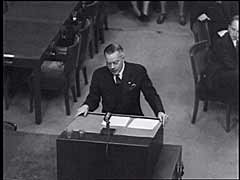
British troops liberated the Bergen-Belsen concentration camp in Germany in April 1945. They filmed statements from members of their own forces. In this British military footage, British army chaplain T.J. Stretch recounts his impressions of the camp.
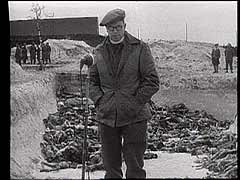
Japanese pilots used the tactic of Kamikaze (suicidal) dive-bombing attacks on enemy warships in 1944 and 1945. The "USS Nevada," despite an escort and efforts to fight off a Kamikaze attack, sustained such a hit in early 1945 off the coast of Japan. The "USS Ticonderoga," a carrier, also sustained such a hit in early 1945 off Formosa (Taiwan). The impact of Kamikaze attacks decreased during the final months of the war in the Pacific, in part because of an improvement in Allied evasion tactics.
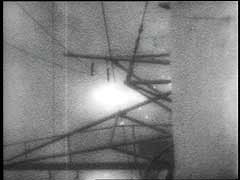
Japanese forces took the Philippine islands between December 1941 and May 1942. After US naval victory in the Battle of Midway (June 1942), Allied forces slowly gained naval and air supremacy in the Pacific war. In October 1944, US forces began the liberation of the Philippines. The campaign on Luzon, largest and most northern of the islands, began in December 1944. This battle footage shows many Japanese soldiers being taken as prisoners of war.

World War II in the Pacific theater ended with the Japanese surrender on September 2, 1945. The surrender was signed in Tokyo Bay aboard the American battleship USS "Missouri." Foreign Minister Shigemitsu headed the Japanese delegation. General Douglas MacArthur accepted the surrender on behalf of the Allies. Admiral Nimitz signed for the US and Admiral Fraser for Britain. Representatives of all the Allied nations attended the signing.

The German-Soviet Pact of August 1939 included a nonaggression pact whereby Germany and the Soviet Union promised not to attack one another for 10 years. Germany was thus able to invade Poland on September 1, 1939, without fear of Soviet intervention. In accordance with secret provisions of the pact, Poland was partitioned between Germany and the Soviet Union. Soviet forces occupied eastern Poland. In this footage, German and Soviet forces meet along the Bug River in central Poland. Less than two years…
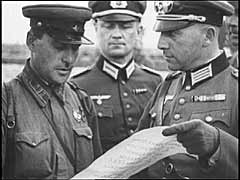
Massive Allied landings of air- and sea-borne forces on five Normandy beaches (codenamed Utah, Omaha, Gold, Juno, and Sword) began on June 6, 1944 (D-Day). The purpose of the invasion was to establish a bridgehead from which Allied forces could break out and liberate France. By the end of the operation's first day, some 150,000 troops were ashore in Normandy. This footage shows Allied forces landing on the Normandy beaches.
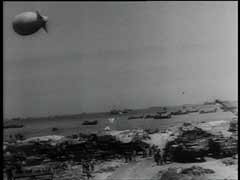
Allied air superiority over Germany was a decisive factor in the success of the D-Day (June 6, 1944) landings in France. This footage shows the Allied bombing of suspected German positions during the battle. Allied air attacks both supported Allied ground operations in Normandy and prevented German reinforcements from reaching the area. The Allies would liberate most of France by the end of August 1944.
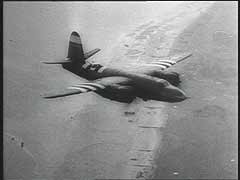
The German army (Wehrmacht) regarded the war in the east as a crusade against communism and not subject to the "normal rules" of war. After the German invasion of the Soviet Union in June 1941, Soviet soldiers followed a "scorched earth" policy to hinder the German advance. In this German newsreel footage, German soldiers approach a burning village, one of many destroyed during the invasion of the Soviet Union.
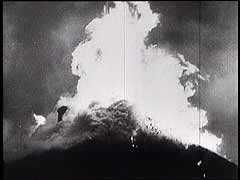
German forces launched Operation "Barbarossa," the invasion of the Soviet Union, on June 22, 1941. The German army made rapid initial progress in the campaign into Soviet territory. In this German military footage, German soldiers separate women and children from men in a Soviet village.
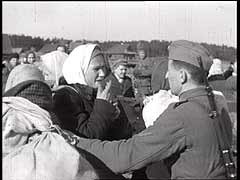
We would like to thank Crown Family Philanthropies, Abe and Ida Cooper Foundation, the Claims Conference, EVZ, and BMF for supporting the ongoing work to create content and resources for the Holocaust Encyclopedia. View the list of donor acknowledgement.